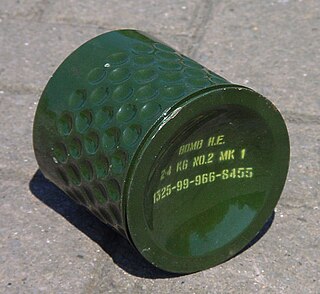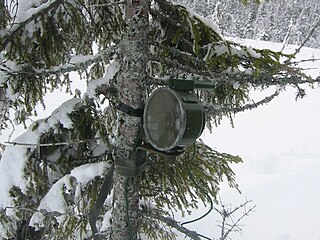
The Misznay–Schardin effect, or platter effect, is a characteristic of the detonation of a broad sheet of explosive. The explosive blast expands directly away from and perpendicular to the surface of an explosive. Unlike the blast from a rounded explosive charge, which expands in all directions, the blast produced by an explosive sheet expands primarily perpendicular to its plane, in both directions. However, if one side is backed by a heavy or fixed mass, most of the blast will be sent in the direction away from the mass.

The HB 876 mine was an air dropped area denial weapon. It was used as part of the JP233 runway denial system and the 'Hades' variant of the BL755 cluster bomb. As a result of the anti-personnel mine ban it was withdrawn from British Royal Air Force service, and the last stockpiles of the mine were destroyed on 19 October 1999.
The M93 Hornet mine is an American anti-tank mine, it is a wide-area mine, capable of attacking targets up to 100 meters away from its position.
The TM-89 is a Russian anti-tank mine first publicly shown in 1993. The mine uses a Misznay Schardin effect warhead capable of producing a 60 mm diameter hole in 100 mm of armour. The mine is fitted with a two-channel magnetic influence fuze, and can be laid from the GMZ-3 mine layer or by the VMR-2 helicopter mine layer.
The TM-83 is a Soviet off-route anti-tank mine, first shown publicly in 1993. The mine consists of a large Misznay Schardin effect warhead and infra-red and seismic sensors.
The 4AHM-100, AHM-200, AHM-200-1, AHM-200-2, PMN-150, and PMN-250 are Bulgarian directional fragmentation mines that can be used with proximity fuzes to function as anti-helicopter mines.
The ATM 2000 and ATM 2000E are Austrian plastic cased anti-vehicle mines using Misznay Schardin effect warhead. The mine uses an electronic microprocessor controlled fuze with magnetic, seismic and pressure sensors allowing it to discriminate between targets. The mine can be laid by hand or by a mechanical mine laying system, and arms ten minutes after being laid. The mine is fitted with an anti-handling device, and can be command detonated.
The ATM-6 and ATM-7 are Austrian off-route anti-tank mines that use Misznay Schardin effect warheads to fire self forging fragments into the sides of armoured vehicles. Both mines are mounted on a pedestal base which is used to aim the mine, and have simple sights to aim the mines. The mines originally could be triggered by a variety of means, including contact wire and infra-red fuses, however as a result of Austrian laws, they now only use command detonation.
The BAT/7 is a circular Italian plastic cased anti-tank landmine with a Misznay Schardin effect warhead. The mine's circumference has a large lip with ribs running vertically from it. The top surface of the mine also has a number of radial ribs with a central circular plate

The FFV 016 is a Swedish designed off-route mine designed for use against lightly armoured vehicles. The mine uses a Misznay Schardin effect warhead to produce a self-forging fragment that has an initial velocity of approximately 2,000 metres per second and can penetrate 60 mm of armour at 30 metres range. The mine's body is circular, with a dished front which is aimed using a simple built in sight along the expected route of the target.
The FFV 018 is a Swedish off-route anti-tank mine. It uses a large Misznay Schardin effect warhead, that generates a fast moving slug capable of penetrating the side armour of a tank. The mine is mounted on a squat tripod, and a built in infra-red sensor package, which detects the target and triggers the mine when the target is in the optimal position.
The HAK-1 is a Hungarian plastic encased anti-tank mine. It uses a Misznay Schardin effect warhead combined with an electronic acoustic and magnetic influence fuze. The mine can be programmed for an active life of between three hours and 150 days. Once the acoustic sensor detects a target, the magnetic influence sensor is used to detonate the mine at the optimal point. The warhead is capable of penetrating 45 mm of armour and producing a 130 mm diameter hole.
The MIACAH F1 is a French off-route anti-tank landmine. It uses a large Misznay Schardin effect warhead to project a powerful self forging fragment capable of penetrating 70 millimetres of armour at a range of 40 metres.
The VS-HCT series of mines are Italian plastic cased anti-tank mines that use Misznay Schardin effect warheads and have a dual seismic and magnetic fuze. The mines are no longer produced and differ in size and shape.

The HPD-1, HPD-2 and HPD-3 are a series of French electrically fuzed anti-tank landmines that use Misznay Schardin effect warheads. The entire series of mines conform to the United States MIL-STD-331.
The MI AC Disp F1 Minotaur mine is a French scatterable anti-tank mine. The mines can also be scattered from 155 millimetre artillery shells, which can hold six of the mines. The mine is cylindrical with two Misznay Schardin effect warheads, one on each side of the mine, with a 600 gram charge. The warhead is claimed to be able to penetrate 90 mm of armour at a distance of 0.5 m. It uses a magnetic influence fuze combined with an anti-handling device which arms itself 64 seconds after launch. At the end of its active life, which is set to between one and 96 hours the mine self-destructs. The land based scattering system can launch mines to a range of up to 300 m.

The MN-111 is a Polish air-dropped anti-tank landmine. The mine is designed for use on soft ground. The mine is cylindrical with six spring-loaded fins attached to one end of the mine, with the cylinder drawn to a point at the opposite end which is topped with a small wind vane. The mine is stored with the fins wrapped round the outside of the mine. Once the mine is dropped from the aircraft the fins spring outward, acting as a drag parachute, slowing the rate of descent to a peak speed of about 60 meters per second. As the mine drops the wind vane spins, generating the power used to arm the mine.

The MPB is a Polish off-route anti-tank mine. It was developed by BELMA with its partner Military Institute of Engineer Technology. The MPB consists of a metal cylinder filled with explosives, mounted horizontally in an adjustable frame. The mine is intended to be hidden from direct view of the intended target, off to the side of a probable vehicle route, usually a road, to attack the weaker armour on the sides and rear of a vehicle. The mine can be triggered by either a contact fuze or an influence fuze based on infra-red and acoustic sensors, and is also fitted with an anti-handling device. When used with the passive infrared fuze, an acoustic sensor detects approaching vehicles and activates the infra-red sensor, which triggers the mine at an optimal moment as the target passes. The mine can be programmed to self-destruct after either 1, 10 or 30 days have passed.
The MSM MK2 is a Finnish belly attack anti-tank mine. The mine has a circular ribbed plastic case that is tapered towards the bottom. It uses an electronic fuze with a combination magnetic and seismic fuze; it also has an anti-handling device. The mine is armed by inserting an arming pin, which completes an electronic circuit. The mine indicates that it is armed by lighting a small LED light which switches off after 10 minutes. When a vehicle approaches, vibrations travelling through the ground trigger the seismic sensor, which activates the magnetic sensor. When a vehicle passes over the mine, the warhead is triggered. First a clearing charge fire, removing up to 100 millimeters of earth from the top of the mine, then a copper-lined Misznay Schardin effect warhead is triggered. This projects a slug of copper at high velocity into the bottom of the target.
The T-93 is an Egyptian scatterable anti-tank mine similar in appearance to the German AT-2 scatterable mine. It can be dispensed from launchers deployed on the ground or mounted on vehicles which can hold as many as 600 mines. The mine is cylindrical with twelve spring-loaded legs folded up against the sides of its body during storage. After the mine is dispensed and strikes the ground, the legs spring open, pointing the mine upright.






